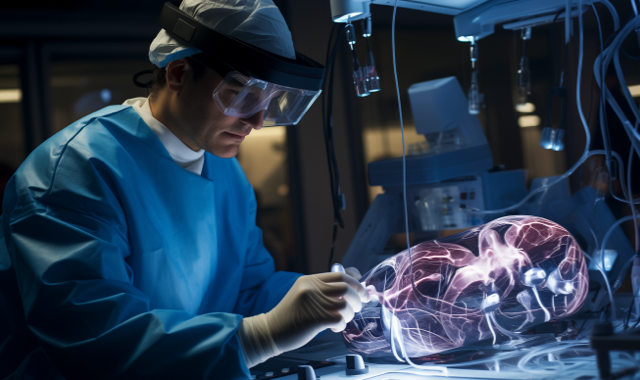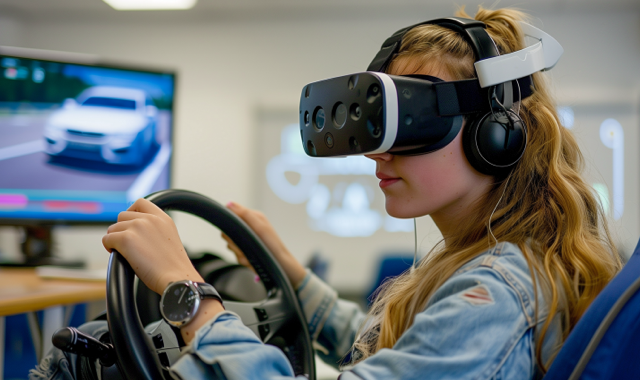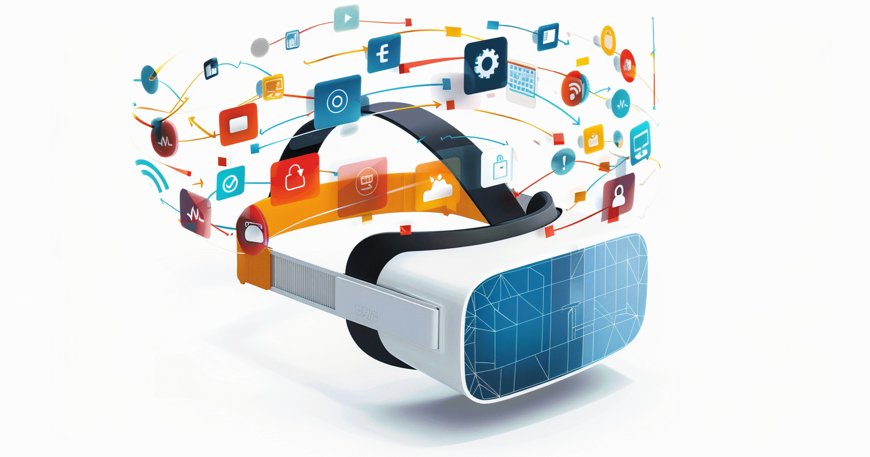Commercial Interest in VR beyond Gaming
While Virtual Reality (VR) has been predominantly used for gaming, businesses in different fields are now exploring how VR can be beneficial to them. VR has the potential to revolutionize many aspects of education, training and healthcare, offering immersive experiences that can enhance learning and improve patient outcomes.
It all started with CAD
The remarkable advancements in 3D modeling, largely driven by CAD technologies over the past two decades, have set a strong foundation for the immersive VR environments we see today. This journey began with the computational demands of 3D modeling, prompting silicon vendors to innovate.
They developed specialized chips capable of handling complex 3D computations more efficiently. This silicon-level advancement was a game-changer, first revolutionizing CGI in movies by offering powerful, yet accessible computing capabilities and later enabling the multi-billion 3D gaming industry and eSports we have today.
All that, paved the way for the creation of commercial, on-demand 3D modeling tools for VR environments now available in consumer-grade VR headsets and smartphones. This transition is nothing short of miraculous – complex 3D virtual environments, once requiring the power of supercomputers like Cray, can now be experienced using devices in our hands or on our heads.
Education: A New Dimension of Learning
VR is shaping up to be a powerful tool in education, especially for today’s students. Digital native kids, who’ve grown up in a digital world, find traditional learning methods – merely repackaging what used to be on the blackboard into slides on tablets and laptops – so underwhelming.
Students are bored. It’s not the gadgets that are dull; it’s the way they’re used. The format doesn’t spark their interest. But exciting original content is really hard to produce. So, despite various options existing, the vast majority of the curriculum delivery is immensely boring for today’s over-stimulated kids.
That’s where VR comes in, the environment is part of the content. It offers a totally different way for students to engage in an interactive experience that grabs and holds their attention for more than a few seconds.
Students are comfortable diving into a learning experience that’s as dynamic and engaging as the digital world they have become accustomed to on their own time, outside of school. Here are some examples that illustrate the tremendous potential:
Virtual Field Trips: A Window to the World
One of the most exciting applications of VR in education is virtual field trips. You can transport students to places or epochs they could never have the chance to visit in person, from historical sites and times to distant planets.

All without leaving the classroom and without the time, inconvenience and costs associated with conventional travel. In a way it is democratizing travel. Of course, its not the same as the real thing, but it sure beats picture the books you and I grew up on!
Conceptual Subjects: Visualizing Complex Concepts
VR shines in its ability to help students understand abstract and complex subjects. For example, in subjects like astronomy or molecular biology, VR can visualize concepts that are difficult to grasp through traditional 2D representations, providing a tangible understanding of the material.Interactive Science Labs: Safer to Experiment
Students can conduct virtual experiments in physics, chemistry, and biology, manipulating variables and observing outcomes in a risk-free environment without blowing anything up! This approach makes science more accessible, particularly for schools that lack the resources for physical labs.Cultural Immersion: Learn languages in context
Students can immerse themselves in foreign language environments and learn in context. For instance, students learning Spanish could virtually visit a market in Barcelona, interacting with vendors and locals in Spanish, enhancing their language skills and cultural understanding.Special Needs Education: Tailored Programs
VR can be particularly beneficial in special needs education. Tailored VR experiences can help students with learning disabilities or autism by creating controlled environments that focus on particular skills or coping mechanisms, providing a personalized learning journey.Healthcare: Enhancing Treatment and Training
VR’s impact on healthcare will be profound. It is set to revolutionize in medical training, especially for complex procedures and surgery. It allows healthcare professionals to practice procedures in a risk-free environment, honing their skills before they perform on real patients. It also has many significant applications in the mental health arena, both in training and in treatment.
Advanced Cardiac Life Support (ACLS) Training
A major teaching hospital in New York has leveraged XR to train anesthesiology residents in ACLS certification, ensuring they are well-prepared for real-life emergencies. This technology enables residents to complete training modules at their convenience, not tying up other people or equipment, so it is efficient and inexpensive.
Empathy and Communication Training
The University of Texas Medical Branch (UTMB) uses AI-powered VR simulations to prepare future healthcare providers for patient interactions. These simulations help develop soft skills like communication and empathy, which are crucial for patient-centered care.
Surgical Training and Planning
Surgeons can practice complex procedures in a virtual environment, reducing the risks associated with training on real patients. Additionally, VR can be used for pre-operative planning, allowing surgeons to explore a 3D model of a patient’s anatomy before actual surgery.

Mental Health Therapy
VR is emerging as a tool in mental health treatment. Therapists are using VR to treat conditions like PTSD, anxiety disorders, and phobias by exposing patients to their fears in a controlled and safe virtual environment, enabling them to learn coping mechanisms.
Physical Rehabilitation
Custom VR programs assist patients in performing specific exercises for recovery, making the rehabilitation process more engaging and motivating. This approach is particularly beneficial for stroke recovery, where relearning motor skills is crucial.
Alleviating Anxiety and Pain
Studies have shown that VR can help alleviate stress and anxiety for patients experiencing acute pain For instance, the Nicklaus Children’s Hospital is using virtual reality tools to put kids at ease during needle-based procedures, reducing reported needle pain by up to 60 %, they say. The VR experience is an underwater simulation that features waves washing over the injection site and a fish nibbling on the patient’s arm.
VR Applications in Other Industries
With a little imagination every industry can find unique applications for VR on top of education and training which is needed universally. Here is a sample of interesting applications:
Automotive Virtual Prototyping
In the automotive sector, VR is not just a tool for design and prototyping but is evolving into a comprehensive platform for safety training, customer engagement, and product development. Looking ahead, VR could enable engineers to test drive virtual prototypes in a variety of simulated environments, reducing the need for physical prototypes and accelerating the design process.
Virtual Drive School and Test Drive
Students can be exposed to hazardous conditions and scenarios hundreds of times and experience spins and accidents, long before getting into a real vehicle. This could lead to much better prepared new drivers. Toyota’s campaign is a testament to VR’s educational potential, using Oculus headsets to simulate the dangers of distracted driving.

VR could also revolutionize the car buying experience, allowing customers to customize and interact with their potential purchase in a virtual space.
Real Estate and Architecture
In real estate and architecture, VR applications extend beyond virtual tours. VR can simulate various scenarios, such as construction phases and safety procedures, enhancing learning and skill development.
Futuristically, VR could enable architects to walk clients through virtual constructions, making modifications in real-time based on feedback. This interactive process could significantly streamline design iterations and client approvals.
Manufacturing Industry
VR applications in safety and training can bridge the skill gap among engineers and workers. Advanced technologies like Industry 4.0 and digital twins integrated with VR could provide actionable insights into the manufacturing process, enabling designers to simulate and rectify design prototypes, reducing production time and cost.
Transportation Industry
In transportation, VR’s impact is evident in pilot training and airport design. Lufthansa’s use of VR for pilot training is a prime example, offering realistic simulations that help pilots handle various flight situations without the need for real-world exercises. Future applications could include virtual traffic systems to optimize urban planning and reduce congestion, as well as immersive training for public transportation operators to improve safety and efficiency.
Entertainment Industry
While VR’s role in gaming is well-established, its potential in the broader entertainment industry is vast. Oculus Cinema and VR demonstrate how VR can create deeply immersive movie and sports experiences, respectively. In the future, VR could enable audiences to participate in live performances, interacting with the environment and performers in real-time. This could redefine the concept of live entertainment, offering personalized and interactive experiences.
Challenges Hindering VR
Despite the promise, VR has been held back by its high cost and connectivity requirements. VR is too demanding for Wi-Fi and BLE and the lack of easy high-speed connectivity, both locally and across the internet has severely crimped its potential. This could change with Wi-Fi 7.
Wi-Fi 7: A Catalyst for VR Evolution
While most Virtual Reality applications today are standalone or tethered systems, not reliant on real-time internet data, this could change a lot in the coming years. The advent of Wi-Fi 7, which is capable of 4x higher bandwidth and lower latency than its predecessor Wi-Fi 6e, further removes performance and latency barriers.
This will lead to more “connected” systems over “tethered” and “standalone” systems, and a greater reliance on the internet for some or all of the content. It should also lead to more multi-player gaming and other real-time applications such as remote medical consultations in high definition without any perceptible lag.
New VR products with Wi-Fi 7
Since Wi-Fi 7 will be a big enabler for VR. We expect vendors to start building more “connected” systems. But this time around they will be going all-in on Wi-Fi with their most ambitious Wi-Fi designs ever, hoping to exploit some of those new features like MLO and 320 GHz wide channels, incorporating 4×4 antenna arrays, perhaps even multiple radios.
As recognized experts in embedded engineering for Wi-Fi , IoT and TinyML we can help you overcome the design challenges and get new products to market on time and on budget.
Content Challenges of VR
The technical, operational even ethical challenges around the deployment of VR are different in different industries and use cases, but one overriding barrier that affects everyone is the creation of VR content and environments in the first place.
eXtended Reality authoring is an entirely new emerging industry, and one early proponent of it is ARuVR. Their platform gives businesses the tools to build their own immersive training experiences in augmented and virtual reality without extensive coding knowledge.
One of the most compelling applications of VR in education is the ability to transport students to different epochs, making history lessons come alive (Program-Ace, 2023). For instance, a history class could use VR to explore the pyramids of Egypt, providing a level of engagement and comprehension that textbooks alone cannot achieve. Students can virtually walk through ancient structures, interact with the environment, and even participate in historical events, leading to a deeper understanding of the subject matter.





